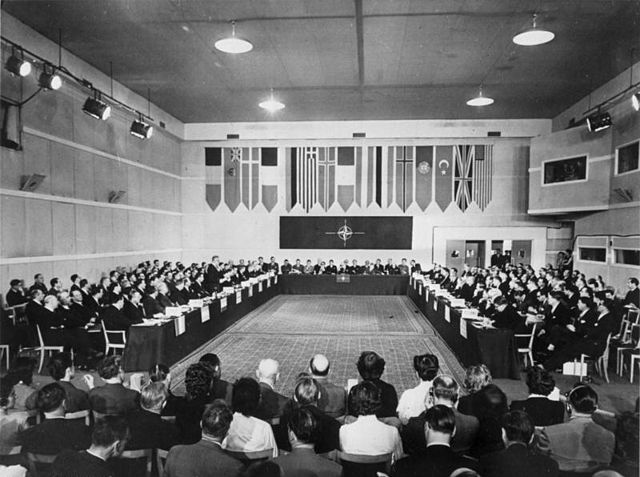The Structure of the North Atlantic Treaty Organization is complex and multi-faceted. The decision-making body is the North Atlantic Council (NAC), and the member state representatives also sit on the Defence Policy and Planning Committee (DPPC) and the Nuclear Planning Group (NPG). Below that the Secretary General of NATO directs the civilian International Staff, that is divided into administrative divisions, offices and other organizations. Also responsible to the NAC, DPPC, and NPG are a host of committees that supervise the various NATO logistics and standardisation agencies.
NATO military command and areas of responsibilities (1954)
NATO E-3A flying with United States Air Force F-16 Fighting Falcons in a NATO exercise.
The North Atlantic Treaty Organization, also called the North Atlantic Alliance, is an intergovernmental military alliance of 32 member states—30 European and 2 North American. Established in the aftermath of World War II, the organization implements the North Atlantic Treaty, signed in Washington, D.C., on 4 April 1949. NATO is a collective security system: its independent member states agree to defend each other against attacks by third parties. During the Cold War, NATO operated as a check on the threat posed by the Soviet Union. The alliance remained in place after the dissolution of the Soviet Union and the Warsaw Pact, and has been involved in military operations in the Balkans, the Middle East, South Asia and Africa. The organization's motto is animus in consulendo liber. The organization's strategic concepts include deterrence.
West Germany joined NATO in 1955, which led to the formation of the rival Warsaw Pact during the Cold War.
The Fall of the Berlin Wall in 1989 marked a turning point in NATO's role in Europe, and this section of the wall is now displayed outside NATO headquarters.
Family photo of the 2023 Vilnius summit.
A USAF aircraft landing during Operation Deliberate Force after the Srebrenica massacre






